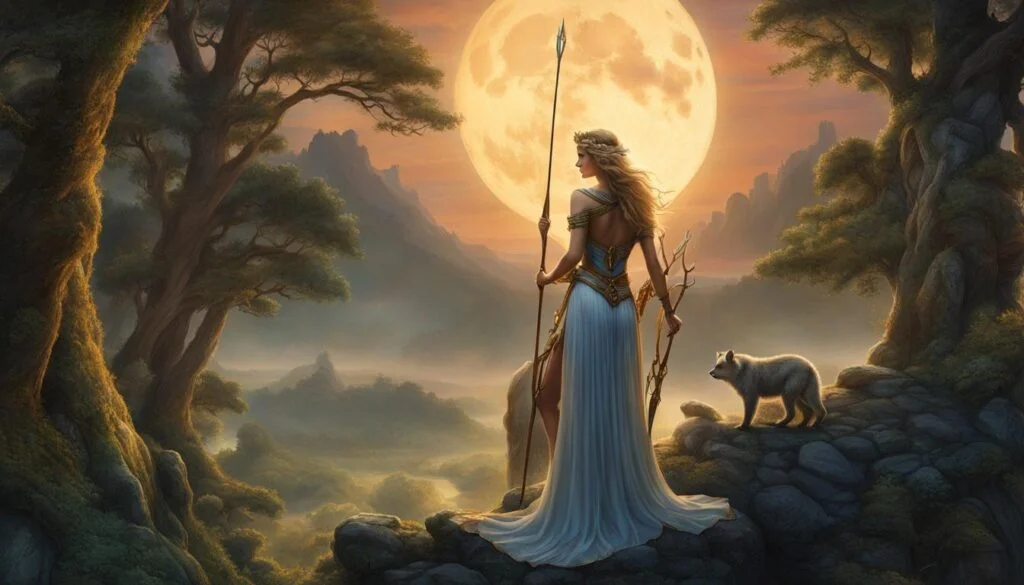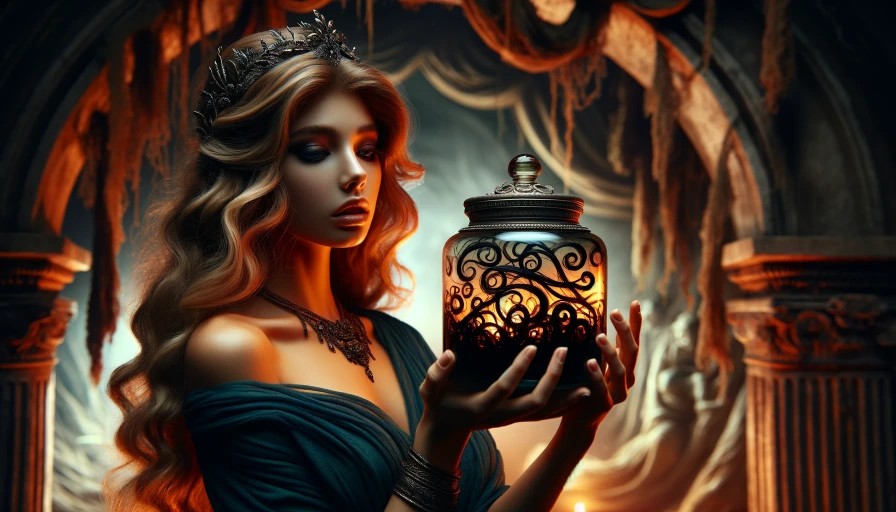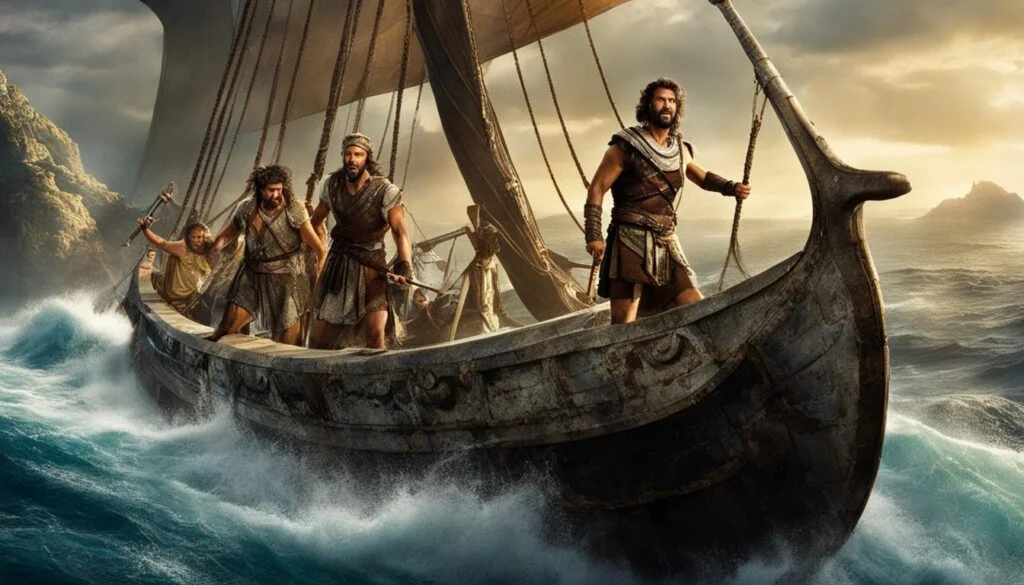Welcome to our exploration of Diana, the fascinating goddess of Greek mythology. Also known as Artemis, Diana is a revered figure associated with the moon and hunting. She embodies strength, femininity, and the cycles of life. Join us as we delve into the mythology, art, symbolism, and influence of this powerful goddess.
Key Takeaways:
- Diana is a goddess in Greek mythology, also known as Artemis.
- She is associated with the moon and hunting.
- Diana symbolizes strength, independence, and female empowerment.
- Her mythology, depictions in art, and worship are significant in ancient Greek and Roman cultures.
- Diana’s influence can be seen in modern culture through characters like Wonder Woman.
Diana in Art: Depictions of a Powerful Goddess
Throughout history, Diana has been a popular subject in art, both in ancient Greek and Roman cultures. Artists often depicted her as a young woman with an athletic build, carrying a bow and accompanied by a hunting dog. These artistic representations showcased her importance as a goddess of the hunt and the moon, as well as her association with female empowerment and independence.
In ancient Greek art, Diana was often depicted in intricate sculptures that captured her grace, strength, and beauty. These sculptures portrayed her in various poses, highlighting her connection to nature and the animal kingdom. The attention to detail in these sculptures, such as the delicate folds of her clothing and the realistic rendering of her facial features, demonstrated the skill and craftsmanship of ancient Greek artists. These sculptures served as testimonials to her divine status and were placed in temples and public spaces, inspiring awe and reverence.
Roman art also embraced Diana as a prominent figure. Paintings and mosaics depicted her as a powerful huntress, often in vibrant colors that showcased her vitality and energy. These artworks captured the spirit of Diana, emphasizing her connection to nature and her role as a guardian of the wilderness. The imagery portrayed her in action, capturing her agility and prowess as she engaged in the hunt, strengthening the association between Diana and the natural world.
One famous representation of Diana in art is the sculpture known as the “Diana of Versailles,” currently housed in the Louvre Museum. This larger-than-life marble statue showcases Diana’s athletic figure, with a quiver of arrows on her back and her hunting dog at her feet. The “Diana of Versailles” is a testament to the enduring inspiration that Diana has provided to artists throughout history.
Artistic depictions of Diana not only celebrated her role as a goddess but also conveyed broader themes of femininity, independence, and the power of nature. These artworks not only served as decorative pieces but also as reminders of the virtues embodied by Diana. They resonated with viewers, highlighting the timeless appeal of this powerful goddess.
Diana in Mythology: Stories and Legends
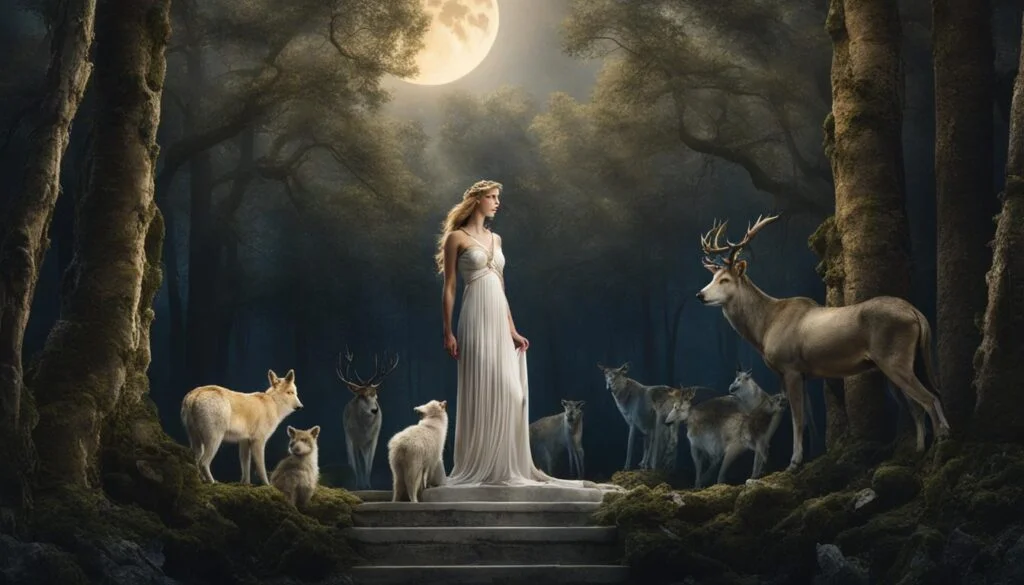
Diana’s mythology is rich with stories and legends that highlight her powers, relationships, and interactions with other mythical figures. One of the famous stories involving Diana is the tale of Diana and Callisto, where Callisto, one of Diana’s companions, is seduced by the Roman god Jupiter disguised as Diana. Other notable stories include Diana’s encounters with Actaeon, Orion, Hippolytus, and Endymion. These myths showcase Diana’s role as a powerful and influential goddess in Greek and Roman mythology.
The Tale of Diana and Callisto
In the story of Diana and Callisto, Callisto was a beautiful nymph and one of Diana’s loyal companions. However, Callisto caught the eye of Jupiter, the Roman god, who disguised himself as Diana to seduce her. When Diana discovered Callisto’s pregnancy, she banished her from the group. Eventually, Callisto gave birth to a son named Arcas, who became a famous hunter. The story emphasizes Diana’s commitment to purity and her intolerance for infidelity.
Diana and Actaeon
In another myth, Diana encounters Actaeon, a young hunter who accidentally stumbles upon her while she’s bathing. As a punishment for seeing her naked, Diana transforms Actaeon into a stag, and he is ultimately killed by his own hunting dogs. This story illustrates Diana’s fierce protectiveness of her privacy and her ability to exact swift justice.
Diana and Orion
Diana’s relationship with Orion is another intriguing tale. According to the myth, Orion was a skilled hunter who sought Diana’s companionship. However, Diana’s brother, Apollo, became jealous and tricked Diana into shooting Orion with an arrow, killing him. This story emphasizes the complexities of Diana’s relationships and the fallout of jealousy and rivalry.
Diana and Hippolytus
In the myth of Diana and Hippolytus, Hippolytus, a young man devoted to chastity and the worship of Diana, is falsely accused of rape by his stepmother. As a result, he is banished and later killed by a sea monster. Diana is unable to save him, and the tragedy highlights the limitations of her powers and the consequences of false accusations.
Diana and Endymion
The myth of Diana and Endymion revolves around the love story between Diana and Endymion, a young shepherd. Diana falls in love with Endymion and puts him into an eternal sleep so that she can visit him every night. This myth symbolizes the ethereal nature of love and desire, as well as Diana’s yearning for a romantic connection.
These stories and legends offer a glimpse into the fascinating world of Diana in Greek and Roman mythology. They illustrate her powers, relationships, and the intricate dynamics of her interactions with other mythical figures. Diana’s mythology continues to captivate and inspire people today, showcasing her enduring impact as a powerful goddess.
Diana in Historical Context: Goddess Worship and Rituals
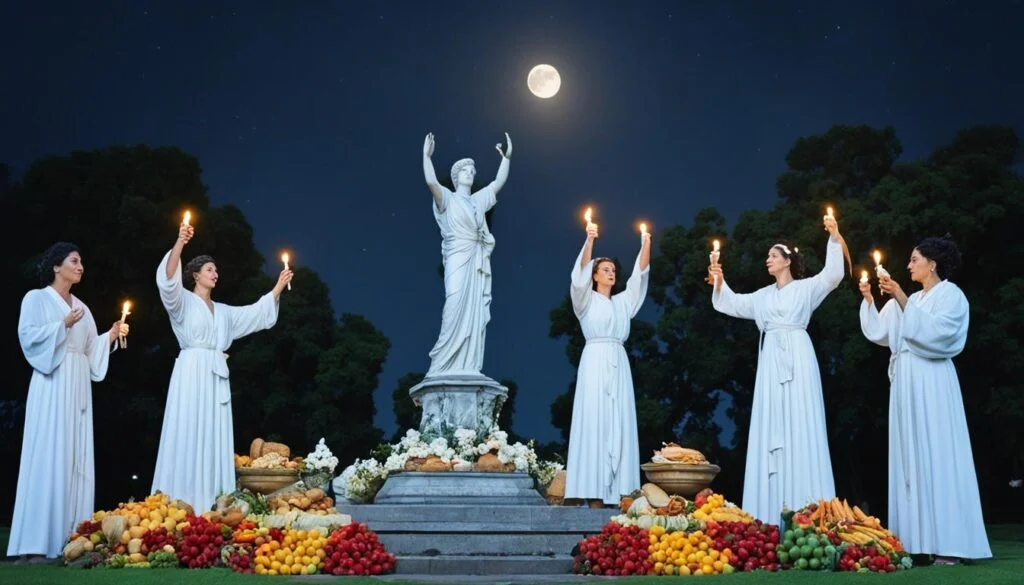
Diana, the revered goddess of the moon and hunting, held immense significance in the religious practices of ancient Greeks and Romans. She commanded a devoted following, with temples dedicated to her worship and a thriving cult dedicated to upholding her divinity.
Within these sacred spaces, worshipers engaged in rituals and ceremonies, seeking Diana’s blessings for hunting success, fertility, and protection. These rituals often comprised offerings, prayers, and processions, fostering a deep connection between the goddess and the daily lives of her devotees.
Diana Worship was an integral part of ancient Greek and Roman religions, demonstrating the profound influence the goddess held over the spiritual landscape of the time. Her worshippers found solace and guidance in her divine presence, turning to her for strength and empowerment.
The Role of Diana Temples
To honor the goddess and facilitate her worship, temples dedicated to Diana were constructed in various locations. These architectural marvels stood as embodiments of divine reverence, serving as spaces for devotees to commune with the goddess.
The grandeur of these Diana Temples reflected the perceived power and importance of the goddess in the ancient Greek and Roman belief systems. They provided a physical focal point for worship, grounding the adoration and devotion of her followers in concrete structures.
The Diana Cult: A Spirited Following
The Diana Cult emerged as a fervent movement dedicated to upholding the worship and veneration of the goddess. Followers of the cult encompassed individuals from various walks of life, united by their deep-rooted belief in Diana’s divinity.
As members of the cult, individuals participated in organized ceremonies and rituals, expressing their devotion to the goddess as a collective. The Diana Cult served as a community that not only upheld traditional values and beliefs but also provided a sense of belonging and camaraderie.
The image above captures the essence of Diana worship, exemplifying the revered status of the goddess in ancient Greek and Roman cultures.
The example of Diana worship in ancient times highlights the importance of Goddess Worship in historical religious practices. The rituals and ceremonies dedicated to Diana showcased the deep-seated belief in her divine power and the profound impact she had on the lives of her followers.
Continue reading to discover the symbolic representation of Diana through Diana’s Symbolism: Moon and Hunt, as we delve deeper into the multifaceted nature of this captivating goddess.
Diana’s Symbolism: Moon and Hunt
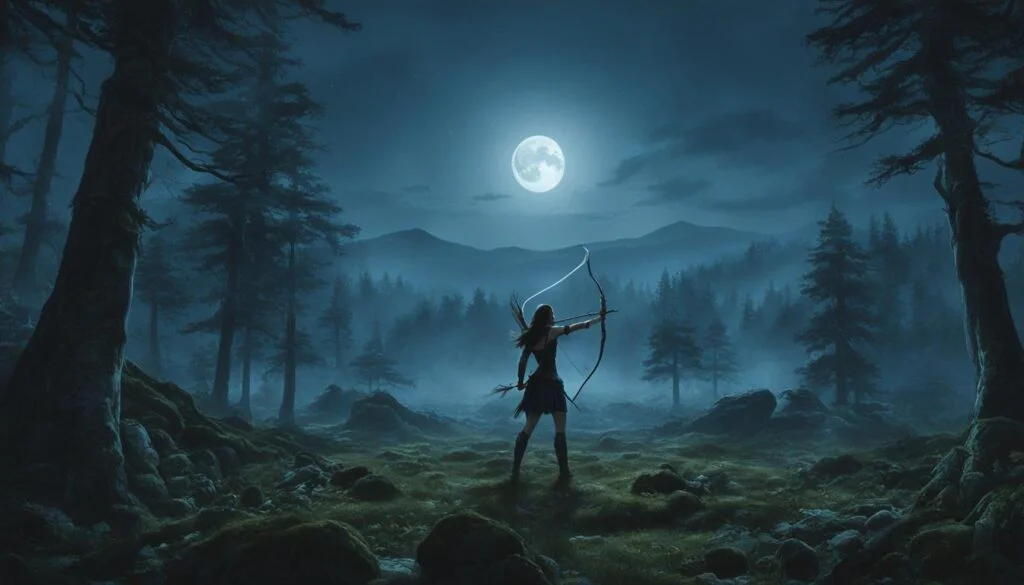
Diana, the goddess of the hunt and the moon, is steeped in symbolism that reflects her multifaceted nature and significance in Greek and Roman mythology. Central to Diana’s symbolism are the moon and the hunt, both representing essential aspects of her divine character.
Associated with the moon’s cycles, Diana embodies the waxing and waning phases, symbolizing the ever-changing nature of life and the celestial world. As the moon goddess, she holds sway over the night sky, casting her ethereal glow and guiding nocturnal activities.
In her role as the goddess of the hunt, Diana symbolizes strength, agility, and independence. Often depicted with a bow and arrow, she exemplifies the precision and skill required for successful hunting. Accompanied by her loyal hunting dog or portrayed with animal prey, Diana evokes the primal connection between humans and the natural world.
But Diana’s symbolism extends beyond the moon and the hunt. She embodies female empowerment, serving as a beacon of strength for women. As a virgin goddess, she champions the value of independence and self-reliance, encouraging her female companions to embrace their autonomy.
In ancient Greek and Roman mythology, Diana’s symbolism permeates their understanding of the world. Her representation as a powerful goddess of the moon and the hunt illustrates the interconnectedness of life, the cycles of nature, and the importance of femininity.
Diana’s Influence: From Ancient Mythology to Modern Culture

Diana, the Greek goddess of the hunt and the moon, continues to exert her influence in modern culture, transcending the boundaries of ancient myth. One remarkable manifestation of her impact is evident in the character of Wonder Woman, who draws inspiration from Diana’s rich mythology. As a feminist icon, Wonder Woman embodies the ideals of female empowerment, reflecting the strength, intelligence, and independence associated with Diana.
Wonder Woman’s enduring popularity has made her a symbol of inspiration for women worldwide. Her portrayal as a superheroine reflects Diana’s influence and the timeless appeal of her archetype. Wonder Woman’s character resonates with audiences, representing the triumph of strength, compassion, and justice over adversity.
In addition to Wonder Woman, Diana’s influence can be seen in various other superheroines and female characters in popular culture. These characters embrace their power and challenge traditional gender roles, standing as symbols of empowerment for women everywhere. By breaking stereotypes and promoting the values of equality and strength, these fictional heroes carry forward Diana’s legacy.
Diana’s impact extends across different mediums, from comics and films to literature and art. Her mythology, with its strong themes of strength and femininity, offers a wellspring of inspiration for contemporary creators. Through these reinterpretations, Diana’s influence continues to shape modern culture and contribute to the ongoing dialogue surrounding female empowerment and feminist ideologies.
Conclusion
Diana, the Greek goddess of the hunt and the moon, is a captivating and revered figure in Greek mythology. She embodies strength, independence, and female empowerment, making her a beloved symbol for many. From her stories and depictions in ancient art to her worship and symbolism, Diana has left a lasting impact on ancient Greek and Roman cultures. Even in modern times, her influence resonates, as she inspires feminist icons and superheroines who champion the same values she represents.
Throughout history, Diana’s mythology has fascinated people, showcasing her multifaceted nature as a goddess. Her stories of encounters with figures like Callisto, Actaeon, Orion, Hippolytus, and Endymion illustrate her power and influence in Greek and Roman mythology. These tales have been passed down through generations, perpetuating the awe and admiration for Diana.
Additionally, Diana’s symbolism as a moon goddess and huntress is profound. She symbolizes the cycles of life and the female connection to nature. Her association with the moon’s phases reflects the ever-changing nature of existence. As the goddess of the hunt, she represents strength, agility, and independence, inspiring individuals to embrace their own power and face challenges head-on.
In conclusion, Diana’s significance in Greek mythology cannot be overstated. Her stories, art depictions, worship, and symbolism all contribute to her enduring legacy. As she continues to inspire and captivate, Diana remains an influential figure, reminding us of the enduring power of female empowerment and the strength of the human spirit.
FAQ
Who is Diana in Greek mythology?
Diana, also known as Artemis, is a revered goddess associated with the moon and hunting.
What is Diana known for?
Diana is known for her skill as a huntress and was often depicted with a bow and arrow.
What does Diana symbolize?
Diana symbolizes female empowerment, independence, and the cycles of life.
How was Diana depicted in art?
Artists often depicted her as a young woman with an athletic build, carrying a bow and accompanied by a hunting dog.
What are some famous stories involving Diana?
Some famous stories involving Diana include her encounters with Callisto, Actaeon, Orion, Hippolytus, and Endymion.
How was Diana worshiped in ancient times?
Temples dedicated to Diana were built, and worshipers would perform rituals and ceremonies in her honor, seeking her blessings for hunting success, fertility, and protection.
What does Diana symbolize?
Diana symbolizes the moon’s cycles, strength, agility, independence, and the protection of women.
How has Diana influenced modern culture?
Diana’s influence can be seen in characters like Wonder Woman, who is often portrayed as a feminist icon and symbol of female empowerment.


